How to cook the perfect rösti
It seems the Swiss reputation for secrecy extends to recipes: with little by way of guidance on röstis, Felicity Cloake was compelled to experiment
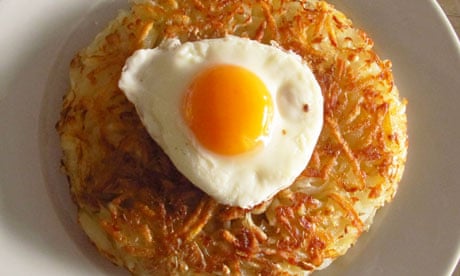
Felicity's perfect rösti. Photograph: Felicity Cloake
For a simple peasant dish with just two ingredients – and humble ones at that – rösti is surprisingly difficult to pin down. In fact, it's almost as if the Swiss want to keep the recipe secret, tucked away in a subterranean vault, as establishing anything concrete about this Alpine favourite, from the type of potatoes used to the cooking method, is a feat akin to scaling the north face of the Eiger. (In fact, it's even harder, because no one, as far as I can tell, has come up with anything even vaguely resembling a definitive rösti recipe.) The only thing I do work out during my initial research is that I've been pronouncing it wrongly all these years: apparently it's reursch-ti rather than row-sti. But frankly, that's the least of my troubles.
While many Swiss consider it their national dish, the world has taken a shine to it too, and it's not as if I haven't eaten a few in my time (most memorably one in the Himalayas that came with a teaspoon embedded in the centre). That said, I was startled to read on one food blog that despite a year-round average humidity of 84% "most restaurants ... in Singapore serve rösti as a side". A taste for fried potato, it seems, is universal. All too often, however, these globalised röstis have an unpleasantly starchy flavour and greasy, raw interior, which makes them a prospect even less appealing than burger bar hash browns as far as I'm concerned.
Then, this summer, I spent a long weekend walking in the Alps, and I realised that, while the Swiss are apparently incapable of producing even a glass of water for less than a tenner, they do make the world's best rösti. Crisp on the outside, soft and meltingly, well, potato-ey within, it was so good it needed no other adornment – although, of course, with mountains to climb, I added liberal amounts of smoked ham and local cheese. But, when I tried to find a recipe to recreate it at home, I came up against a wall of silence: and with no definitive way to cook a rösti, the only thing to do was experiment.
In the raw
This, if you will, is the rösti equivalent of the cream-first v jam-first scone war – some people parboil the potatoes before grating, and others don't bother. No-one online really seems too concerned about this divide – they acknowledge it, without going into the pros and cons of each approach. It irks me though; which is more traditional? And, more importantly, which is better?
The Oxford Companion to Food is uncharacteristically silent on the matter, but, after a frustrating half hour trawling the endless regurgitation of the internet, I finally discover that, according to a reliable sounding book called the Culinary Arts & Traditions of Switzerland, raw potato is typical only in the Zurich area – the rest of the country insists upon parboiling them first.
Should I, as a non-partisan foreigner, back the bankers, or side with the cowbell swingers? Only one way to find out. Using the Leiths Cookery Bible recipe as my template (which, in its original form, calls for boiled potato), I make two different röstis. For the first, I grate two large potatoes, wring them out then press them into a flat cake in a hot, well-buttered frying pan and cook for 10 minutes on each side. For the other, I parboil two potatoes until just tender; once they're cool enough to handle, they're grated and cooked in exactly the same way.
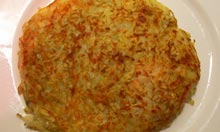
A rösti cooked from raw potatoes.
Photograph: Felicity Cloake
The raw potato rösti looks far more like my image of the dish – the strands of potato are still distinct and it's ragged and strawlike around the edges, but, although cooked through, it has a starchy flavour, and oddly raw texture that I recognise with dislike. The other reminds me more of a bubble and squeak potato cake made with leftover mash; more to my taste, admittedly, but I suspect it wouldn't pass the Swiss test.
I also try a trick suggested online by chef Patrick Williams; salting the grated raw potatoes to "draw out" the excess water, a technique familiar to me from coleslaw recipes, which makes the rösti crisper on the outside, but does nothing for the starchy flavour or crunchy interior.
Pre-chilled?
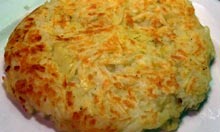
Chilled pre-boiled, peeled potato rösti.
Photograph: Felicity Cloake
For some Swiss, it's not enough to parboil the potatoes – they must be done a day in advance and chilled before grating. It certainly makes them easier to grate, and they hold together better in the pan too, although I think a couple of hours in the fridge would do the trick.
Peeled or nay?
I'm pleased to see many recipes call for potatoes boiled in their skins – peeling is a small effort, admittedly, but every little helps. Conscience dictates, however, that I try one with a naked potato too; but I'm astonished at how much flavour the skin gives the rösti; peeling, thank goodness, is much more trouble than it's worth.
Playing a binder
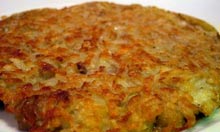
Valentine Warner recipe rösti.
Photograph: Felicity Cloake
Some rösti chefs, daunted by the prospect of marshalling hundreds of pieces of grated potato into a coherent cake, add extra ingredients to their rösti to bind the pieces of potato together. Valentine Warner, for example, pops in a hefty amount of clarified butter and a tablespoon of flour in the recipe in his new book, The Good Table.
This rösti is very easy to flip, needing less prodding and agitation than others, but I'm not convinced by the finished texture, which is slightly grainy, or the rich, buttery flavour, which seems to deny me the prospect of any other toppings. (I love the idea of his distinctly un-Swiss accompaniments though: salmon roe, sour cream, chopped onion and dill. Nearly as good as smoked ham and Swiss cheese.)Floury versus waxy
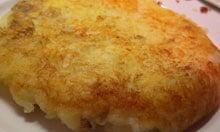
Floury potato rösti. Photograph: Felicity Cloake
I'm astounded to discover there's no clear consensus as to whether a floury or a waxy potato is preferable for this dish. Mark Hix and Jane Clarke specify floury, Val Warner and Leiths go with waxy.
The floury versions are deliciously fluffy and well browned, but, when parboiled, more like a mashed potato cake than a rösti. The individual strands of waxy potato, meanwhile, retain their shape better once made into a cake, and the finished röstis have a crunchier texture, even when made from parboiled potatoes, which sets them apart from ordinary potato cakes.
Goose fat v butter
Nick Nairn fries his rösti in goose fat, which makes sense: if it can give roast potatoes that glorious crisp finish, then perhaps it will work the same magic on my röstis. Although I prefer the flavour of butter with the potato, I'm forced to admit that his are distinctly crunchier, so I decide to use a mixture of both in my final recipe.
Perfect potato rösti
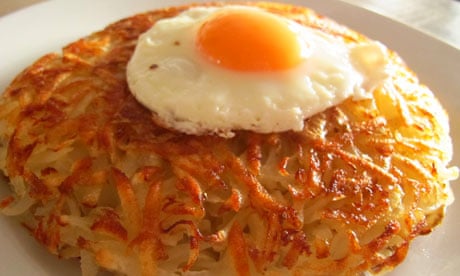
Felicity's perfect rösti. Photograph: Felicity Cloake
They're glorious plain, but a rösti can be made into a complete meal with the addition of onion, bacon and nutty Alpine cheese. (Some areas even add coffee; those crazy Swiss, eh?). All you really need for a good rösti, however, is some firm potatoes, parboiled to give a soft, melting interior, and fried in plenty of hot butter and goose fat until crisp, and a few mountains to climb to work up an appetite.
- Serves 4 as a side dish, 2 as a main course
- 2 medium-sized waxy potatoes
- 1 tbsp butter
- 1 tbsp goose fat
- 1. Parboil the potatoes in salted water until just tender, but not soft. Allow to cool, and chill for at least a couple of hours.
- 2. Coarsely grate the potatoes and season. Heat half the fat in a small, heavy-based frying pan until sizzling, and then add the grated potato, allow to cook for a couple of minutes and then shape it into a flat cake, pressing down as lightly as possible. Allow to cook for a couple of minutes, then gently shake the pan to loosen the potato.
- 3. Continue to cook for about 10 minutes until golden and crisp, then place a plate on top of the pan and invert it so the cake sits, cooked-side up, on the plate.
- 4. Add the rest of the butter and goose fat to the pan and, when hot, slide the potato cake back into the pan the other way up. Cook for another 10 minutes, then serve.
Is a rösti nothing more than a hash brown with Alpine airs and graces, or a distinctive national dish Switzerland should be proud of? What are your top tips, and what other foods do you favour to keep off the mountain chill?